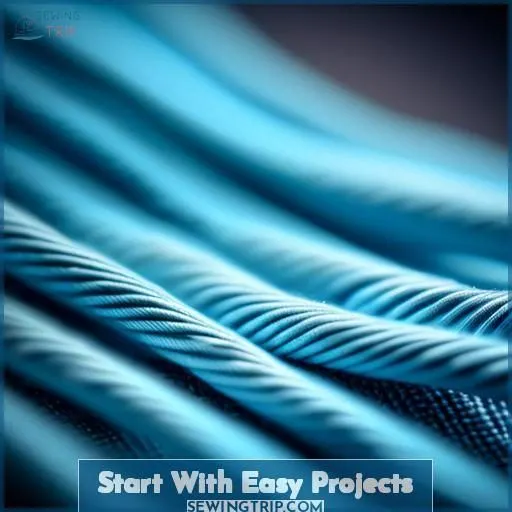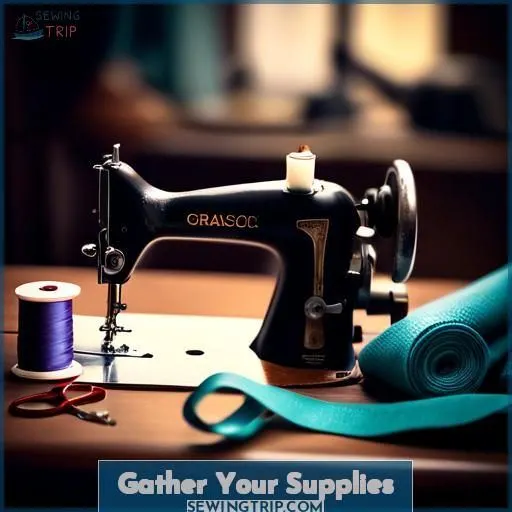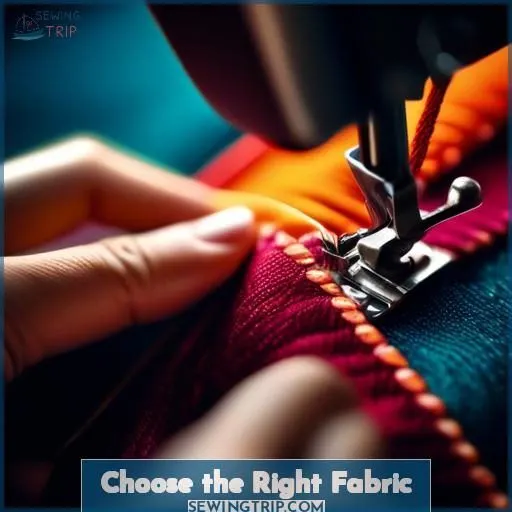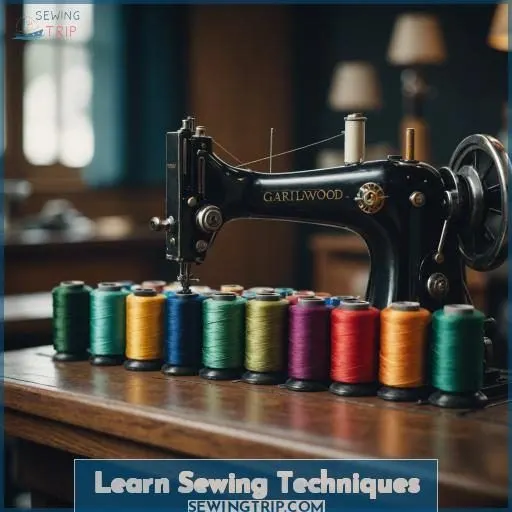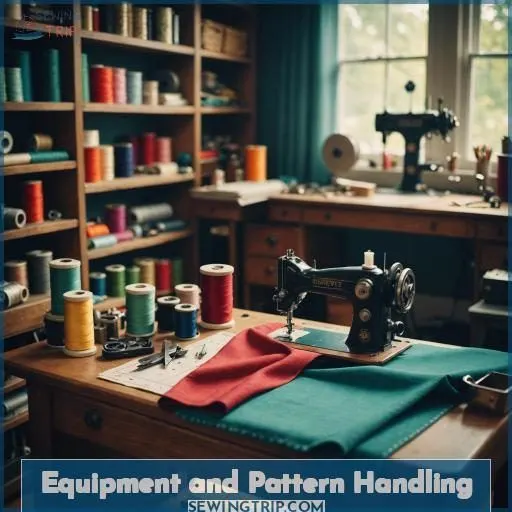This site is supported by our readers. We may earn a commission, at no cost to you, if you purchase through links.
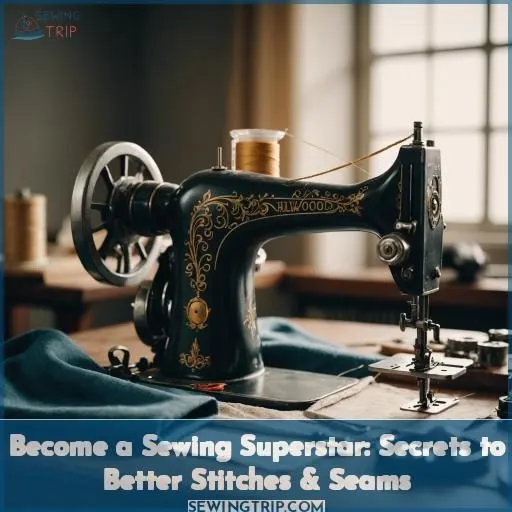 To become a sewing superstar, start with easy projects that build your confidence and proficiency. Prioritize mastering fundamental skills before attempting complex techniques. Use a fitting checklist to verify accurate measurements, and explore sewing shortcuts to enhance your creations.
To become a sewing superstar, start with easy projects that build your confidence and proficiency. Prioritize mastering fundamental skills before attempting complex techniques. Use a fitting checklist to verify accurate measurements, and explore sewing shortcuts to enhance your creations.
Practice patience, persistence, and a willingness to learn. Select a sewing machine suited to your skill level and budget, and choose fabrics and patterns designed for beginners.
Learn sewing terminology, fabric characteristics, and techniques like pressing seams, clipping curves, and hemming to elevate your sewing game. By following these steps, you’ll soon be stitching with precision and pride.
Table Of Contents
- Key Takeaways
- How to Be Better at Sewing?
- Start With Easy Projects
- Gather Your Supplies
- Choose the Right Fabric
- Learn Sewing Techniques
- Equipment and Pattern Handling
- Avoid Purchasing Expensive Sewing Machines as a Beginner
- Avoid Using Household Scissors for Fabric Cutting
- Explore Free Online Patterns as an Alternative to Purchasing
- Choose Patterns Designed for Beginners to Avoid Alterations
- Prioritize Patterns That Do Not Require Major Alterations
- Familiarize Yourself With Pattern Markings and Symbols
- Follow Pattern Instructions Carefully to Avoid Errors
- Understand the Grainline and Its Importance for Fabric Placement
- Avoid Eyeballing the Straightness of Pattern Pieces on Fabric
- Frequently Asked Questions (FAQs)
- Conclusion
Key Takeaways
- Start with simple projects to build confidence and proficiency in fundamental sewing skills.
- Choose a sewing machine and fabrics suitable for your skill level and budget.
- Learn sewing terminology and techniques like pressing seams, clipping curves, and hemming to enhance your sewing skills.
- Practice patience, persistence, and a willingness to learn to overcome common sewing challenges.
How to Be Better at Sewing?
To become better at sewing, follow these 10 tips:
- Learn the basics: Familiarize yourself with your sewing machine and basic supplies like pins, rotary cutters, and thread.
- Practice: Sew regularly to improve your skills and build confidence.
- Use the correct tools: Choose the right needle for your fabric and use a rotary cutter for accurate cutting.
- Take care of your machine: Clean and maintain your sewing machine to guarantee smooth operation.
- Master hand sewing: It’s a valuable skill that can be used for various projects.
- Use coordinating thread: Match your thread color to your fabric for a professional look.
- Choose good quality materials: Invest in high-quality fabrics for better results.
- Finish your seams: Properly finish your seam allowances for a neat and polished appearance.
- Pay attention to details: Include topstitching and special trims to enhance your projects.
- Study and learn from others: Observe clothing in stores, your closet, and online resources to improve your sewing skills.
Start With Easy Projects
Embark on your sewing odyssey with elementary projects that bolster your confidence and proficiency. Commence with rudimentary patterns, such as a tote bag or a pillow cover, to hone pattern placement, seam finishes, and fabric preparation.
Prioritize fundamental sewing skills, such as threading a needle and operating a sewing machine, before embarking on more intricate techniques. Utilize a fitting checklist to guarantee accurate measurements and avoid common sewing blunders.
As you advance, delve into sewing shortcuts and techniques to elevate your creations. Remember, the cornerstone of becoming a sewing virtuoso lies in patience, practice, and an eagerness to learn.
Gather Your Supplies
Gathering your sewing supplies is an essential step in becoming a sewing superstar. Here are the sewing essentials you’ll need to get started:
- Sewing machine: Choose a machine that suits your skill level and budget.
- Fabric: Select fabrics appropriate for the pattern and intended use.
- Sewing patterns: Choose patterns designed for beginners to avoid alterations.
- Fabric scissors: Keep these separate and secure to avoid damaging your fabric.
- Measuring tools: Use guides to take accurate measurements for pattern adjustments.
Choose the Right Fabric
Selecting the appropriate fabric is essential for the success of sewing projects. Choose fabrics that are suitable for your pattern and intended purpose, and spend time familiarizing yourself with sewing vocabulary – it’ll make comprehension of instructions and techniques effortless.
Select Fabrics Appropriate for the Pattern and Intended Use
With regard to sewing, the type of fabric you select can make or break your project. The fabric characteristics, such as drape, weight, and care, play a significant role in determining the success of your sewing endeavor. Here’s a simple table to help you understand the basics:
| Fabric Type | Drape | Weight | Care | Sewing Technique |
|---|---|---|---|---|
| Cotton | Moderate | Light to Heavy | Easy | Straight Stitch |
| Linen | High | Light to Medium | Easy | Basting Stitch |
| Silk | High | Light | Delicate | Satin Stitch |
| Wool | Low | Heavy | Special | Zigzag Stitch |
| Denim | Low | Heavy | Special | Topstitch |
| Chiffon | High | Light | Special | Edge Stitch |
| Velvet | High | Heavy | Special | Understitch |
Learn Sewing Terminology to Understand Instructions and Techniques
Learning sewing terminology is critical for understanding pattern instructions and mastering various techniques. Here are four key terms to familiarize yourself with:
- Appliqué: This term refers to the process of stitching a piece of fabric onto another fabric, often used in quilting and garment embellishment. It can be done by hand or with a sewing machine, and the edges of the appliqué are typically sewn close to the edges of the shape for a neat finish.
- Bias: In sewing, the bias refers to the diagonal direction of a fabric, where it has the most stretch and drape. Bias binding is a type of binding used to finish seams and edges, and it’s cut on the bias to allow for greater flexibility.
- Binding: Binding is a term used to describe the process of finishing a seam or edge with a strip of fabric, often used to hide raw edges and add a decorative touch. Binding can be made from various materials, including bias tape and other types of fabric.
- Understitch: Understitching is a technique used to secure a facing or lining to a garment, ensuring that it sits smoothly and doesn’t roll outward. It involves sewing a line of stitching close to the seam allowance, usually with a blind hem stitch.
Understanding these terms will help you navigate pattern instructions and sewing techniques more effectively, ultimately leading to better stitches and seams.
Learn Sewing Techniques
As you sew, be sure to press your seams as you go – this will enhance the overall quality of your garment. Additionally, clip the seam allowances around the neckline and armholes to help them lie flat and smoothly.
Press Seams as You Go to Improve Garment Quality
Pressing seams as you go is essential for improving garment quality. Use a presser foot to press the seam allowance in the direction of the arrow on the pattern piece. For a professional finish, use steam setting on your iron and apply even pressure.
A 2-column, 3-row table can help you understand the importance of pressing seams at different stages of the sewing process, from seam finish to understitching.
By incorporating this technique into your sewing routine, you’ll notice a significant improvement in the overall quality of your garments.
Clip Seam Allowances Around Neckline and Armhole Curves
Trim your curved seam allowances around the neckline and armhole curves to prevent excess bulk and enhance the appearance of your garment. Utilize fabric scissors and trim precisely along the seam allowance, avoiding the fabric itself. This technique is essential for achieving smooth, polished seams.
Pull Straps to the Outside and Understitch Facings
Pulling straps outwards and securing facings with stitching are essential steps in seam finishing. To achieve this, follow these steps:
- Pull straps outwards: After attaching the facing unit, pull the straps to the exterior of the dress. This guarantees that the straps aren’t visible from the exterior and aids in preventing the facing from gathering.
- Stitch facings underneath: Stitch the facings underneath by sewing along the edge of the facing, close to the seam allowance. This aids in holding the facing in its place and prevents it from rolling or flipping outwards.
- Secure with pins: Pin the facings in place along the understitching line on either side of the zipper tape. This guarantees that the facings are equally distributed and properly aligned.
- Tack facings in place: Tack the facings in place at the underarm seams using a small, decorative stitch. This adds a professional touch and aids in securing the facings in place.
Tack Facings in Place at Underarm Seams
To secure the facing layer at the underarm seam, you’ll use a tacking technique. This involves sewing a few loop stitches through the facing layer and the garment’s seam allowance at each seam. This will guarantee that the facing is permanently directed to the inside of the garment and remains in place.
This tacking should be done at the shoulder and side seams, and the stitches should only be visible on the inside of the garment and on top of the facing at the side and shoulder seams.
Hem the Dress
Hemming a dress is the final touch to perfecting your sewing project. Here’s how to do it right:
- Choose the hem length based on the fabric choice and pattern guidelines.
- Press the fabric with a press cloth to prevent shine and wrinkles.
- Finish the seam with a seam finish that matches the pattern and fabric.
- Match the pattern at the hem line for a clean finish.
Equipment and Pattern Handling
As a beginner sewer, you don’t need to deplete your financial reserves on a costly sewing machine. Instead, investigate quality machines within your spending limits that fulfill your requirements. Cutting fabric with household scissors may impair your materials – invest in a suitable pair of fabric scissors and maintain them separately for superior outcomes.
Avoid Purchasing Expensive Sewing Machines as a Beginner
As a beginner, it’s essential to start with friendly machines that suit your needs and budget. Don’t overspend on expensive machines. Instead, research before purchase to find conscious options that offer affordable quality. Remember, you can always upgrade later as your skills progress.
Avoid Using Household Scissors for Fabric Cutting
Don’t risk your fabric’s fate by reaching for household scissors! Invest in a pair of fabric shears with sharp blades for cutting accuracy. Safety concerns are real, so choose specialized scissors with rounded tips and ergonomic handles. Keep your tools separate and secure to maintain cutting precision.
Explore Free Online Patterns as an Alternative to Purchasing
Embrace the realm of complimentary patterns online! With an abundance of choices accessible, you can discover patterns that complement your taste and financial constraints. Here are four reasons why delving into complimentary patterns is a novice-friendly approach:
- Variety of styles: From informal to formal, there’s a pattern for every event.
- Online availability: Access patterns at any time, from any location, without venturing outside your residence.
- Budget-friendly: Conserve funds by refraining from acquiring costly patterns.
- Beginner options: Numerous complimentary patterns are meticulously crafted for novices, reducing the necessity for alterations.
Choose Patterns Designed for Beginners to Avoid Alterations
As a novice sewer, it’s crucial to select patterns that are tailored to your proficiency level to avert alterations. Consider patterns that align precisely with the size chart, such as the Portrait Blouse pattern, which ensures a suitable fit. Retro styles often demand more fitting modifications, so contemplate employing customization techniques.
In the table below, we’ve outlined patterns that are appropriate for beginners and those that necessitate minimal alterations.
Prioritize Patterns That Do Not Require Major Alterations
Prioritize patterns that don’t require major alterations to save time and effort. Here are five time-saving techniques for beginner sewers:
- Choose patterns with simple shapes and minimal darts: These patterns are easier to sew and often require fewer adjustments.
- Select patterns with consistent sizing: Patterns that fit well without needing extensive alterations will save you time and frustration.
- Opt for patterns with clear instructions: Patterns with detailed instructions and diagrams will guide you through the sewing process more efficiently.
- Consider patterns with built-in ease: Patterns that include ease (extra room) in the design will often fit better without needing extensive adjustments.
- Look for patterns with similar measurements: If you have a specific body type, choose patterns that are designed for people with similar measurements. This will reduce the need for extensive alterations.
Familiarize Yourself With Pattern Markings and Symbols
To become a sewing expert, it’s essential to acquaint yourself with pattern markings and symbols. These symbols act as a guide for your sewing endeavor, guaranteeing that your garment construction is accurate and precise. By comprehending these symbols, you can align parts of your sewing piece together smoothly, avoiding potential mistakes and ensuring a professional finish.
Common pattern markings include:
- Grain lines: These markings indicate the direction in which the fabric should be cut, following the natural grain of the fabric.
- Fold lines: These symbols represent the edge piece of fabric aligned with the fold, indicating where to fold the fabric before sewing.
- Notches: These are used to match up different pattern pieces at the correct points, ensuring seamlines align correctly.
- Button and buttonholes: These markings indicate the placement of buttons and buttonholes on your garment.
- Darts: These are shown as diamond shapes or two lines spreading out from one point, indicating where to fold and stitch the fabric for curves, allowing for a better fit.
- Tucks and gathers: These markings resemble a square that’s missing one line, with dots at the bottom indicating where to pull in the fabric and vertical lines and dots at the top indicating where to sew your stitches.
Follow Pattern Instructions Carefully to Avoid Errors
Follow pattern instructions diligently to avert mistakes and guarantee a garment that fits well. Pattern markings and symbols are essential for correct placement and alignment of pattern pieces on fabric. Grainlines, which show the lengthwise thread of the fabric, should be aligned with the selvages and adhered to to attain the desired fit and drape.
Understand the Grainline and Its Importance for Fabric Placement
Understanding the grainline and its importance for fabric placement is like finding the North Star in a sea of textiles. Here’s why:
- Direction Matters: Aligning with the grain makes sure your project doesn’t warp out of shape.
- Strength and Stability: Following the warp gives your creations durability.
- Aesthetic Appeal: Grain-aligned fabric drapes beautifully.
- Precision: It’s the secret sauce for sewing success.
Avoid Eyeballing the Straightness of Pattern Pieces on Fabric
Avoid eyeballing the straightness of pattern pieces on fabric to guarantee accurate fabric placement. Use marking techniques, such as pinning or chalking, to align patterns correctly. Eyeballing can lead to misaligned seams and uneven garments. By following this rule, you’ll achieve better results and improve your sewing skills.
Frequently Asked Questions (FAQs)
What are the most common sewing mistakes beginners make?
Rushing through projects, neglecting fabric prep, struggling with pattern interpretation, and misusing equipment – these are the common pitfalls that can trip up sewing newbies. Slow down, read instructions carefully, and invest in the right tools for a smoother sewing experience.
How can I choose the right needle for my fabric?
For example, if you’re sewing delicate chiffon, choosing the right needle is like finding a needle in a haystack – pick the wrong one and you’ll end up with a tangled mess. The key is matching the needle size and type to your fabric for smooth, professional results.
What is the importance of pressing seams before sewing?
Pressing seams is the secret sauce – it tames those unruly fabrics, locking in the shape and structure. Skipping this step? You’re basically sewing with one hand tied behind your back. Don’t leave home without that trusty iron!
How can I avoid ripping seams when using scissors?
Snipping seams with scissors can be a delicate dance – like performing open-heart surgery with a butter knife. The key is steady hands, patience and using the right tools. Treat your fabric like a precious gem, and it won’t let you down.
What are some unconventional sewing tools I can use at home?
Unleash your inner MacGyver! Repurpose binder clips to hold fabric taut, use magnets to corral loose pins, and harness the power of clothespins as makeshift pattern weights. These unsung heroes can revolutionize your sewing sessions at home.
Conclusion
Sewing, my friend, is an engrossing canvas that unfolds with each stitch. By mastering the basics and embracing the adventure, you’ll soon be a sewing virtuoso, stitching with accuracy and style.
Embrace the obstacles, commemorate the successes, and let your imagination soar. With patience and tenacity, you’ll uncover the mysteries to superior stitches and seams, transforming fabric into masterpieces.
So, take up that needle and thread, and let your sewing mastery shine.

